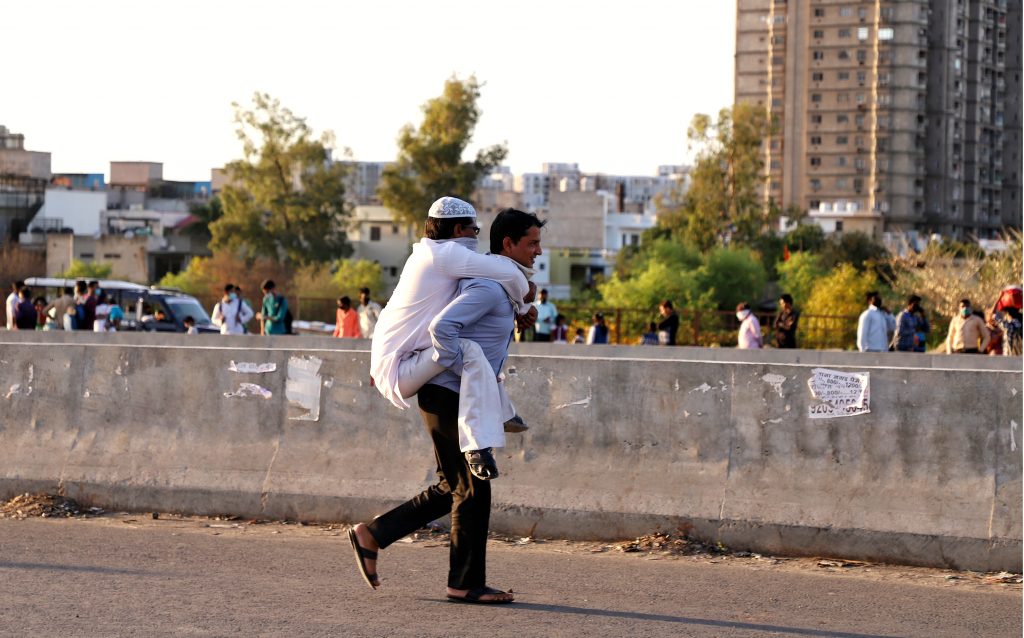
Photo by Suresh Kumar Pandey.
As the COVID-19 pandemic made its way to India, a country with over 1.2 billion people, the worst hit by the government’s response and its fall out are the thousands of migrant laborers, vulnerable and stranded in cities. In response to the coronavirus crisis, the national government led by prime minister Narendra Modi announced an unprecedented country-wide lockdown for 21-days on March 23. The notice period was just four hours. All state borders were closed and people were asked to stay where they were. By then, however, some states had already announced lockdowns on their own.
India’s first coronavirus case was reported on January 30 in Kerala. As of March 29, there are 1,024 confirmed cases with 27 deaths so far. 95 people have recovered.
At this moment, India is fighting with two crises: COVID-19 pandemic and the migration crisis, of poor unprotected laborers who are at the hard bottom of social stratum.
With businesses, shops and construction sites all shut in the wake of COVID-19, a large number of migrants have not only lost their daily wage jobs but are also deprived of food and shelters. As a common practice, laborers working for daily wage jobs like construction sites or manufacturing companies dwell at their workplaces. The lockdown also restricted trains, buses and other modes of transportation from operating until April 15, essentially leaving this section of the society stuck in a cruel limbo .
Thousands of Indian nationals, stuck in COVID19 prompted lockdowns, have been brought home from different parts of the world. However, the poor who migrate from Indian villages to cities in search of livelihood amid declining jobs and rising unemployment, have been traveling home from Indian metropolises on foot.
At least 45 million people leave their towns and villages in search of better opportunities in metropolitan cities in India each year, according to government reports.
The Indian state has so far failed to mitigate the mass reverse migration crisis. Some states are proving food and shelter to the stranded but is far from enough. As a result, the migration crisis has claimed a higher number of deaths until March 28. So far, 19 deaths were reported due to COVID-19 and at least 22 people lost their lives in attempts to reach home. One child died of starvation.
On late Saturday evening, Delhi saw hundreds and thousands of migrants gathered at the inter-state bus depot, desperately trying to get to their respective villages and towns. There were pregnant ladies with toddlers, old citizens, and even people carrying physically disabled on their backs in hopes to reach their safe zones. The exodus of migrants is not only limited to Delhi but has gripped the entire nation, with Maharashtra having the most number of cases followed by Kerala.
Outlook India correspondent Salik Ahmad, who has been covering the migration crisis amid the pandemic outbreak, says, “There are approximately 3,000,000 migrants living in the national capital, most of them working for lower-income or daily wage jobs.” Realizing that they may soon enter the phase of starvation once they outlive their savings, most of them have started to move back to their villages in hopes of getting at least a meal a day, Salik added. Most of the migrants are from villages in Uttar Pradesh and Bihar.
Migrants are fearful that the virus and its ripple effects are going to last months and their menial savings won’t last even days. They are worried about what they would feed their families if the situation doesn’t return to normal soon. When assurances from government fail, they have started to return to the limited safety of their homes, hoping to fight the coronavirus if it comes in their way of fighting death by starvation.
Entering the fifth day of severe lockdown, the streets are oddly deserted and highways have no travelers. However, people have set off on foot to make their way home. Two eighteen-year-olds had set on a journey on foot from a town in Punjab to another town in Uttar Pradesh, which is approximately 745 kms away. The boys had already been walking for four days and had another five-six days of distance to walk, says Salik.
Deaths due to lockdown in India. A thread:
— Kanika (@_kanikas_) March 29, 2020
Four people died after they were ran over by a vehicle on a highway while they were walking home situated in another city. In another incident, a man lost his life during his 200 km long walk to his village.
Earlier, the government of Uttar Pradesh, India’s largest state with over 200 million people, deployed at least 1000 buses to get the migrants home from neighboring Delhi. “Although there are buses, the drivers are over-charging the travelers who have already exhausted their money. There are not enough buses for all the districts,” says Salik.
The desperation to reach home and be with one’s family has defied the purpose of self-isolation and lockdown in India. In some cases, the police have resorted to violence, arresting people for not following the lockdown protocol. “… but they can’t starve themselves to death. They will come out for respite- in search of food,” the journalist adds.
There is little knowledge about the outbreak amongst the lower-income people in India. Starvation, on the other hand, is the immediate and real problem that relegates the severeness of the strengthening pandemic.
The central government has unveiled a $23 billion plan to help the poor in getting access to essential items. The state governments are also monitoring the pandemic crisis based on Wuhan’s reports to deal with the crisis.
As of today, India is in the second phase of the pandemic outbreak which refers to local transmission of the disease. The Press Information Bureau of India clarified: India has not yet reported any community transmission, which sets the beginning of stage three of the disease.